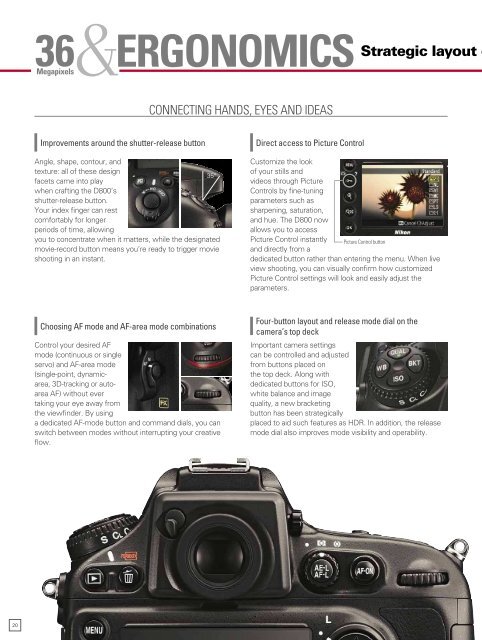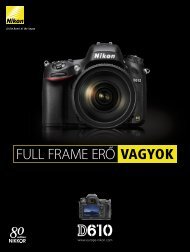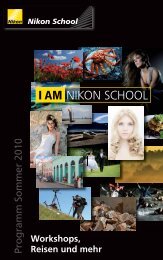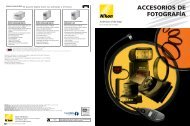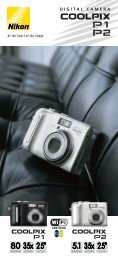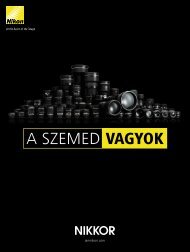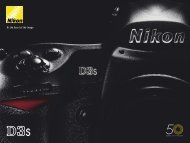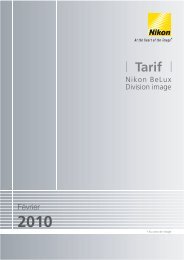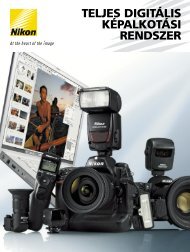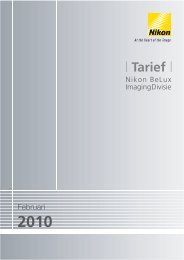Nikon D800
Nikon D800
Nikon D800
You also want an ePaper? Increase the reach of your titles
YUMPU automatically turns print PDFs into web optimized ePapers that Google loves.
36&ERGONOMICS<br />
Megapixels<br />
Improvements around the shutter-release button<br />
Angle, shape, contour, and<br />
texture: all of these design<br />
35°<br />
facets came into play<br />
when crafting the <strong>D800</strong>’s<br />
shutter-release button.<br />
Your index finger can rest<br />
comfortably for longer<br />
periods of time, allowing<br />
you to concentrate when it matters, while the designated<br />
movie-record button means you’re ready to trigger movie<br />
shooting in an instant.<br />
Choosing AF mode and AF-area mode combinations<br />
Control your desired AF<br />
mode (continuous or single<br />
servo) and AF-area mode<br />
(single-point, dynamicarea,<br />
3D-tracking or autoarea<br />
AF) without ever<br />
taking your eye away from<br />
the viewfinder. By using<br />
a dedicated AF-mode button and command dials, you can<br />
switch between modes without interrupting your creative<br />
flow.<br />
CONNECTING HANDS, EYES AND IDEAS CREATIVE EXPANSION TOOLS<br />
Direct access to Picture Control<br />
Customize the look<br />
of your stills and<br />
videos through Picture<br />
Controls by fine-tuning<br />
parameters such as<br />
sharpening, saturation,<br />
and hue. The <strong>D800</strong> now<br />
allows you to access<br />
Picture Control instantly Picture Control button<br />
and directly from a<br />
dedicated button rather than entering the menu. When live<br />
view shooting, you can visually confirm how customized<br />
Picture Control settings will look and easily adjust the<br />
parameters.<br />
Four-button layout and release mode dial on the<br />
camera’s top deck<br />
Important camera settings<br />
can be controlled and adjusted<br />
from buttons placed on<br />
the top deck. Along with<br />
dedicated buttons for ISO,<br />
white balance and image<br />
quality, a new bracketing<br />
button has been strategically<br />
placed to aid such features as HDR. In addition, the release<br />
mode dial also improves mode visibility and operability.<br />
Strategic layout of buttons and dials for fluid operation<br />
Expand dynamic range: HDR (High Dynamic Range)<br />
The <strong>D800</strong> can shoot two<br />
frames in a single shutter<br />
release, but at different<br />
exposures: one overexposed<br />
and one underexposed.<br />
The camera then instantly<br />
combines them to create<br />
an image covering a wider<br />
dynamic range. The range can be widened by up to 3 EV for<br />
different looks, all full of saturation and tonal gradation, while<br />
the smoothness of the edge where the two exposures meet<br />
can be adjusted for a more natural appearance.<br />
Note: Tripod use is recommended.<br />
Accurate confirmation of level shooting: Dual-axis<br />
electronic virtual horizon<br />
With the <strong>D800</strong>, you can always<br />
check the LCD monitor or<br />
the viewfinder for both the<br />
camera’s position in relation<br />
to the horizontal plane and its<br />
pitch (forward or rear rotation).<br />
This can enhance compositional<br />
accuracy, particularly when LCD monitor display<br />
shooting still lifes, landscapes<br />
and architecture.<br />
Refined color temperature control: Minute control over<br />
white balance<br />
The <strong>D800</strong>’s white balance<br />
proves its reliability even when<br />
using an external flash and live<br />
view in the studio environment.<br />
The monitor hue of live view<br />
and resulting image’s white<br />
balance can be individually<br />
set so that the difference<br />
between the two is minimized. Furthermore, for even more<br />
control, color temperature can be manually set in 10-kelvin<br />
increments or in mired units.<br />
Shoot achieving reduced blur with zoom lenses in dim light:<br />
Auto shutter speed control for auto ISO sensitivity control<br />
The <strong>D800</strong> comes equipped with an auto option for minimum<br />
shutter speed that automatically controls the balance<br />
between shutter speed and the ISO sensitivity based on the<br />
focal length of the lens being used. This can be particularly<br />
useful when using a zoom lens, because the camera can<br />
automatically choose the shutter speed to reduce camera<br />
shake. What’s more, through the operation of ISO button<br />
and sub-command dial, auto ISO sensitivity control can be<br />
immediately turned on or off, without needing to enter the<br />
menu.<br />
• Shutter speed: 1/25 second • Aperture: f/4<br />
• Focal length: 24mm • Sensitivity: Auto (ISO 900)<br />
©Cliff Mautner<br />
• Shutter speed: 1/100 second • Aperture: f/4<br />
• Focal length: 120mm • Sensitivity: Auto (ISO 6400)<br />
©Cliff Mautner<br />
Shoot with multiple formats in one camera: Image area<br />
options<br />
The <strong>D800</strong> offers four image area options: FX format (35.9 x<br />
24.0 mm), 5:4 (30.0 x 24.0 mm), 1.2x (30.0 x 19.9 mm), and<br />
DX format (23.4 x 15.6 mm) with all cropped image areas<br />
visually masked in the viewfinder. DX format offers approx.<br />
1.5x, and 1.2x crop offers approx.1.2x telephoto effect.<br />
When a DX NIKKOR lens is used, DX format is automatically<br />
selected.<br />
Image enhancement options: In-camera editing<br />
Captured images and movies can be altered and edited incamera<br />
and on the fly if required, all without the need to<br />
resort to a computer. Retouch menus include an array of<br />
useful features such as NEF (RAW) processing, resize,<br />
distortion control, fisheye, miniature effect, red-eye<br />
correction, filter effects and image overlay, as well as the<br />
ability to designate the start and end point of movie clips all<br />
at once, in order to save them more efficiently.<br />
20 21<br />
Viewfinder display


